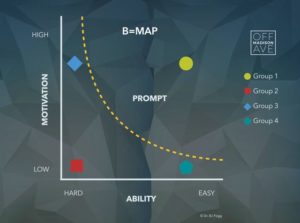

Behavior Design is one of the latest trends in marketing strategic planning process. How its principles can be applied in everyday campaign planning? We asked US communication professional Roger Hurni who manages his own company Off Madison Ave and currently is the global chair of Worldcom PR Group.

Behavior Design is simply a set of models and methods that allow communications professionals to evaluate audiences’ behaviors and in turn create new behaviors to follow. This work can range from starting new initiatives or assessing a specific problem to solve. Results are realized through the calibration of three elements of human behavior: a person’s motivation to act, a person’s ability to perform a behavior and the prompt which starts the action.
This is going to seem strange, but the traditional planning process is already using Behavior Design. However, it is instinctive rather than methodical. Behavior Design provides a way for everyone to analyze and develop new programs based on human behavior, rather than what has worked in the past. What I’ve seen is that communications professionals really don’t have a way to explain why a program does or does not work. What action would make the most sense to do next and why? Behavior Design provides them the language and tools they need to accomplish that. Case in point: When a PR professional wants a journalist to write a story about a client, they don’t contact every journalist on the planet. They don’t even contact all the journalists who cover that topic. They look for the most motivated journalists first – then, they make certain those journalists have the information necessary which maximizes their ability to write the story, i.e., access to the CEO, press materials, images, etc. Finally, they prompt those journalists through a series of contact points: email, phone calls or in-person briefings.
Media is usually the prompt in the facilitation of a behavior, which is critical. After all, if a prompt isn’t being received then a behavior will never occur. The right mix starts by evaluating each audience’s motivations. By understanding why the motivation exists, you can create an associated behavior that is in line with that motivation. The crucial part in the media mix comes from syncing the message delivery with the motivation. For example, Behavior Design would examine the psychological need being fulfilled through the use of different social media channels. Facebook, for instance, is most associated with community and our need to belong to certain groups. Instagram, however, fulfills our need to express a certain aspect of our lifestyle. Pinterest is typically focused on aspirational topics and exists as an expression of our desires. The same message across all three of these channels would fail. Therefore, the message needs to be altered to align with a person’s motivation for using each of those channels.
Behavior Design’s models and methods are the most refined way of facilitating a behavior change. It provides marketers the most comprehensive process for strategically evaluating why something is working and more importantly why it is not. By employing Behavior Design, a marketer can best serve their client from a myriad of perspectives that go beyond communications. These can include sales, operations and customer experiences in particular. The real end benefit for a marketer would be their ability to exceed a client’s expectations while simultaneously building a long-term integral relationship.
There is a simple order when implementing the Behavior Design process with new initiatives. It starts with evaluating and understanding the motivations of your potential audience. Then, you need to identify the specific behaviors for those audiences which are most motivated, while ignoring the rest. That might sound simple, but I’ve often found that many marketing professionals have a difficult time with that. Not paying attention to a potential customer can be hard but the reduced effort and costs are worth it. Lastly, you need to design a series of prompts for each of the behaviors, which could be many things. Most often for marketers it takes the form of paid media, earned media or customer interactions with employees.
To demonstrate how this works, let’s look at a company in the swimming pool supply business. For confidentiality purposes we will call them Blue Waters. They are a retailer of pool chemicals, equipment and pool items which make owning a pool more enjoyable. From a motivational perspective, Blue Waters believes that everyone can take care of their own pool which, though it may be true, in reality it’s not. There are many pool owners who simply have no desire whatsoever to maintain their own pool. They lack motivation. They may not want to spend the time or learn how to do it. Or perhaps the savings isn’t worth the convenience of hiring a pool care professional.

From an audience analysis perspective, we have four groups:
The main problem is that nearly all marketers will say, “If you own a pool, you’re a potential customer.” But Group 4 has no real motivation to take care of their pool. A company can spend way too much money, time and effort going after an audience whose behavior they can’t change. That means no marketing or communications should be done which says you should dump your pool care service professional and save money by taking care of the pool yourself.
In this case, Blue Waters’ already has Group 1 as existing customers (for the most part). The real opportunity for Blue Waters is to shift a percentage of Group 3 to change their behavior, in turn growing their customer base.
In order to do that, Blue Waters has to make certain that group has the ability to perform a set of behaviors by making each one as easy as possible. For instance, instead of asking each of those customers in Group 3 to take care of their pools themselves from now on, it is much easier to break that large behavior down into smaller behavioral steps, known as Behavior Sequences. Next, you implement Behavioral Transference – essentially using the completion of one behavior to prompt the next behavior. It looks like this:
There are dozens of sequences, each designed to help the customers in Group 3 learn to take care of their own pool. Include a separate set of behavioral sequencing for customers in Group 1.
Finally, the prompts along the sequences take many forms. Some are interactions with the store associate. Others are based in a previous behavior. Some will take the form of social media posts showing the enjoyment of the pool or the expertise that Blue Waters offers for free. In this case, supported materials came in the form of new how-to videos on YouTube, coupled with earned media communications around pool safety along with new blog content. This Behavior Designed program has helped Blue Waters realize a significant lift in sales.
From a Behavior Design perspective, COVID-19 has shifted our motivations around social norms and purchasing behaviors. That means when interacting with customers who are in the store, personal space is going to feel different in a post-COVID era. Customer communication needs to focus around helping, along with an undertone of caring instead of outright selling — especially when trying to offer the customer an inducement like a coupon or a sale. Furthermore, COVID-19 has taught consumers to buy online. For most people that experience was limited to specific items that would transport well or could be easily returned. But now, consumers are more comfortable with purchasing items online that were once purchased in-store, such as groceries and clothing. The in-store experience will return but it won’t be the same and there will be far less of it. If brands haven’t fully embraced the new consumer behaviors which are grounded in a digital world, they are going to go out of business.
As a founder of Off Madison Ave and LighthousePE, Roger Hurni brings a unique perspective as a creative visionary, brand strategist and business owner to the clients he serves. His background spans national to international agency and entrepreneurial experience.
Because of his multinational brand experience, Roger’s clients seek him out to assist them with their strategic initiatives. Using the alignment of behavioral prompts along the customer path, Roger develops the strategic marketing interactions necessary for companies to realize new levels of customer engagement and operational effectiveness.
Roger’s work has been honored throughout the industry, including awards from The CLIOS, Cannes Lions, ADDYs, Radio Mercury Awards and New York Festivals. He has served on the Arizona Interactive Marketing Association board as President and was twice awarded Interactive Marketing Person of the Year. He has been named Ad Person of the Year and was an Ernst & Young Entrepreneur of the Year Finalist. For more than seven years, Roger also served as a member of the prestigious Walter Cronkite Endowment Board. Currently, Roger is the Global Board Chair for the Worldcom Public Relations Group, an organization with nearly 90 partners in more than 50 countries.
Off Madison Ave is headquartered in Phoenix, Arizona, USA. They have one of those typical “started in a garage” kind of stories (back in 1998). There is even a garage door in their office as a tribute to the agency’s humble beginnings. The running joke is that the agency was started with VC money — that’s not Venture Capital but Visa Cards. It’s totally true, too.
By employing the principles of behavioral science, Off Madison Ave has become one of the leading Behavioral Marketing Agencies in the USA. The agency’s foundation in Behavior Design drives the initiatives it develops for clients and powers all of its services — creative, branding, public relations, media, digital and machine learning marketing software. With clients that range from regional-based to multi-national organizations, Off Madison Ave’s unique approach enables them to facilitate the behavioral changes their clients need to achieve their goals.
Off Madison Ave is a partner with the Worldcom Public Relations Group. Through Worldcom, the agency is able extend their reach globally on behalf their clients.